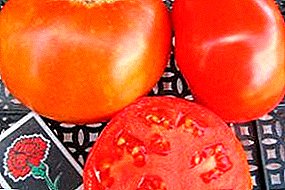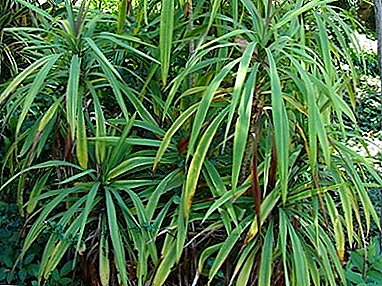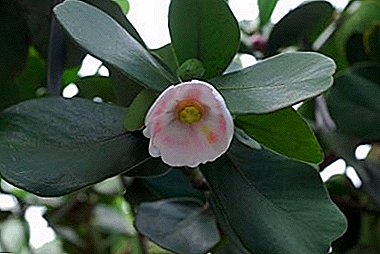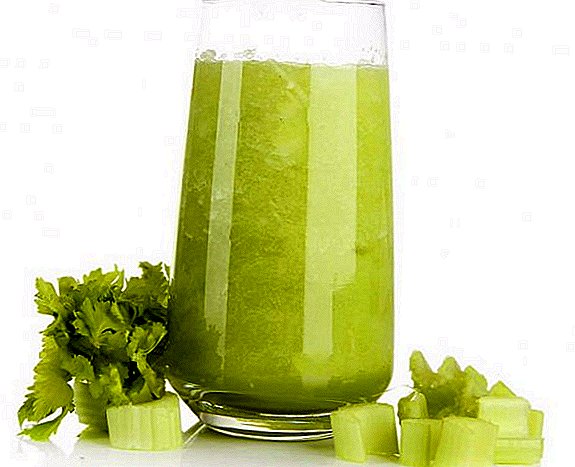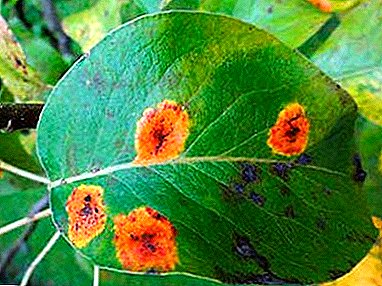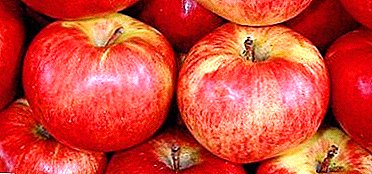
Aport is one of the most popular varieties of apple with a mysterious, but very interesting story.
The fruits of this tree are characterized high biological valuewhile they are widely available.
Further in the article you can:
- read the full description of the characteristics of the apple variety Aport;
- find out how this apple tree is planted and grown;
- see a photo of apples.
What kind is it?
 In gardening, depending on the period of fruit ripening, All garden crops, including apple trees, are divided into:
In gardening, depending on the period of fruit ripening, All garden crops, including apple trees, are divided into:
- summer (July-August);
- autumn (August-September);
- winter (October).
Aport, according to maturity, refers to late autumn and winter view. Is enough winter hardy variety.
Apple Aport has two clones: variety with the same name Aport Alexander, but with a striped color, as well as Aport blood-red.
The winter apple varieties also include: Belfleur Bashkir, Bryansk, Veteran, Rennet Chernenko and Korey.
Aport variety description
Apple Aport Alexander is usually above average, with a bright green crown and multi-colored fruits.
Often reach large sizes. Characterized by round, enough powerful crown, markedly branched, but sparse. Her diameter is from 7 to 10 meters.
The shoots are long, medium in thickness, brownish in color with a small amount of lentils. The branches are strong, placed at a large angle.
 The leaves are mainly placed at the ends of small branches.
The leaves are mainly placed at the ends of small branches.
The leaf of the Aport Alexander is dark green, rounded, slightly flattened, of medium size (120 millimeters in length and 75 millimeters in width).
The leaf plate is slightly curved, the edges are slightly pubescent with a thick neural net. Petioles on average reach sizes up to 40 mm.
The fruits are truncated conical and very large.
Parameters of the average fetus:
| Weight | 250-270 g |
| Height | 70-75 mm |
| Width | 92-95 mm |
| Peduncle | 1.5-1.8 cm |
But very often the fruits reach gigantic sizesby example in 500-600 g. The color of the fruit is red-yellow-green. Peel smells good, shiny, not thick, but not thin.
 If you remove it, it is yellow-green with bright red patches, stripes and strokes, which in some places smoothly transform into each other. Subcutaneous points are clearly visible on the surface.
If you remove it, it is yellow-green with bright red patches, stripes and strokes, which in some places smoothly transform into each other. Subcutaneous points are clearly visible on the surface.
The fruit has a broad bulb heart placed in the upper part. Seed chambers are closed and fairly large.
The flesh is very fragrant, fine-grained, white-green in color and not very dense.
To taste apples Aport sweet and sour with a wine aftertaste, and how they look you will see in the photo.
The following varieties can also boast of excellent taste: Orlovsky Pioneer, Ekranny, Big Narodnoe, Orlinka and Aromatny.
A photo








Breeding history
The exact origin of the apple has not been established. But still in 1779 Bolotov A.T. mentioned it as a variety that has long been known and distributed under the name "Gusevskoe".
It is believed that in Poland and Ukraine a variety of apples Aport was already known in the twelfth century. The first time the name Aport was mentioned in Kazakhstan at the beginning of the twentieth century.
Growing region
 Due to the unidentified history of the appearance of the apple tree, Aport Alexander is rather difficult to assert about the zone of its natural growth, but it is grown in the greatest amount on the territory of Kazakhstan.
Due to the unidentified history of the appearance of the apple tree, Aport Alexander is rather difficult to assert about the zone of its natural growth, but it is grown in the greatest amount on the territory of Kazakhstan.
And, interestingly, there Alexandrov apple Aport gives the largest and sweet fruit.
But this apple tree is easily planted with gardens. all over the world, because she is able to take root in virtually any climatic conditions.
Yield
Fruiting occurs at one-year growth and only occurs for 7-8 year. Further fructification lasts for 40 years.
Harvest, according to the literature, can be collected annually and in large quantities, but more often it happens in a year. Productivity is big, On average, one tree gives up to 150 kg. The shelf life of such apples two to four months.
High-yielding are also considered varieties: Shtriel, Aloe Early, Nastya, Kuibyshev and Antonovka ordinary.
 In winter, apples should be stored in wooden containers or racks, it is also possible in cardboard and wooden boxes.
In winter, apples should be stored in wooden containers or racks, it is also possible in cardboard and wooden boxes.
The optimum temperature is 0 ° C. It is desirable that the fruits were calibrated in size.
Planting and care
When planting a tree using classic fertilizer. In the care of the apple Aport is not whimsical.
Apple tree Aport Alexander is planted in two periods:
- autumn (late September - early October);
- spring (late April).
Aport Alexander - winter apple varietyand therefore advised to choose after all autumn period for planting. You need to choose seedlings with a developed root system.
Landing sites must be well drained. To make the tree grow strong and bring maximum yield, it is recommended use the soil loam.
TIP: If you cannot get such a soil, you can dig a hole with a depth and diameter of one meter, fill it with sand, compost and peat crumb. This will create even better conditions for the germination of seedlings.
Be sure to water the tree plentifully immediately after planting.
IMPORTANT! When planting, avoid places where groundwater is located close to the surface. Otherwise, the seedling will be in the water, and the tree will rot.
 The next year after planting, in the spring, it is important to form a deciduous apple crown.
The next year after planting, in the spring, it is important to form a deciduous apple crown.
It is necessary to trim the ends of each branch.
In April you MUST irrigate trees with pest control compounds.
This procedure should be performed twice:
- when buds began to swell on branches;
- before the buds bloom.
After that, the tree no longer needs to be fertilized for a year. It is very important to water the tree heavily, especially in the summer.
Diseases and pests
Apple Aport Alexander can also be prone to attack of pests and the onset of various diseases, like other varieties. And often it is not only the tree that is affected spoil the whole crop.
 Fruits are obtained or not ripe, or with a whole list of flaws.
Fruits are obtained or not ripe, or with a whole list of flaws.
To avoid defeat, it is important to isolate the apple tree from other crops in the garden, carefully monitor the plant and constantly disinfect and fertilize the soil.
If the disease attacked a tree, then the first sign will be blemish on bark.
The most frequent guest on the trunk is tinder mushroom. It strongly affects the trunk of an apple tree, but it affects the fruit indirectly.
Important in the early stages of such the fungus is immediately eliminated. Daily stay of the fungus on the bark pulls a lot of strength and nutrients that are needed for apple normal existence.
Healthy wood will naturally suffer. It is important to destroy the fungus at its very roots. Otherwise, after some time, the mushroom “settles” again in the same place.
After removing the infection, the place in which it grew must be disinfected. The main thing is that the cut is even, most often it takes place to make a couple of more cuts.
Processing should be carried out by copper sulphate.after which it is desirable to paint over the treated place oil paint. If this is not done, the wound will soon become a nest for various types of pests.
 The second common disease is scab. Its peculiarity is that it first of all affects the leaves of the tree, and then moves to the fruit.
The second common disease is scab. Its peculiarity is that it first of all affects the leaves of the tree, and then moves to the fruit.
The trunk remains perfectly healthy. The trees of Aport Alexander include to a scab-resistant variety.
The cause of this fungus can be air stagnation inside the crown of the tree or high humidity.
The first signs of scab are the appearance of green-brown spots on the leaves, also in a large number of small brown, forming a crust, spots on the fruit.
To prevent this disease, it is important to carry out prevention, which consists of:
- soil ash;
- crown formation;
- potash fertilizers;
- feeding with compost.
If the disease still hit the tree, you should immediately begin its treatment. The treatment is due to tillage around culture and tree spraying various mixtures.
As a rule, this is a universal set of measures, which is the prevention and treatment of virtually all diseases of the garden tree.
 The best treatments are: a solution of urea (on average, 7-8 liters is needed per tree), copper oxychloride, which must be used first before flowering, and then during the appearance of the first fruits, and Bordeaux liquid, which can be easily replaced with copper sulphate.
The best treatments are: a solution of urea (on average, 7-8 liters is needed per tree), copper oxychloride, which must be used first before flowering, and then during the appearance of the first fruits, and Bordeaux liquid, which can be easily replaced with copper sulphate.
Do not ignore the appearance of all sorts of pests in the garden. For information on how to carry out prevention against the Codling moth, the fruit stalk, the hawthorn, silkworms and the mining moth, read in separate articles on our website.
Apple-tree Aport Alexander brings the fruits of high organoleptic properties with high nutritional and biological value.
They are not whimsical in growing and caring for them. The tree is beautifully grown in almost any environment.
In this video you can get acquainted with the history of the variety Aport and attempts to revive it in our time.


